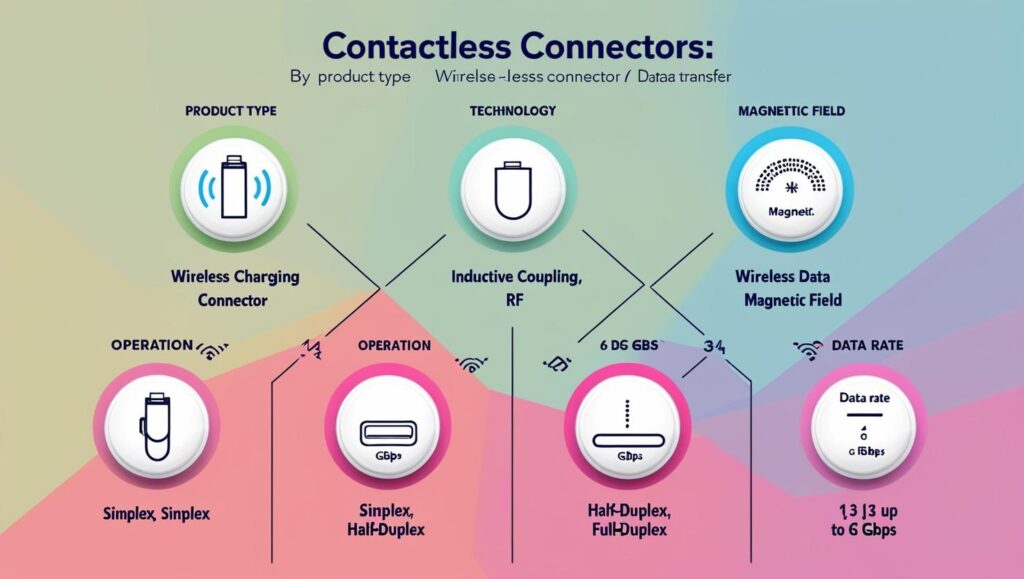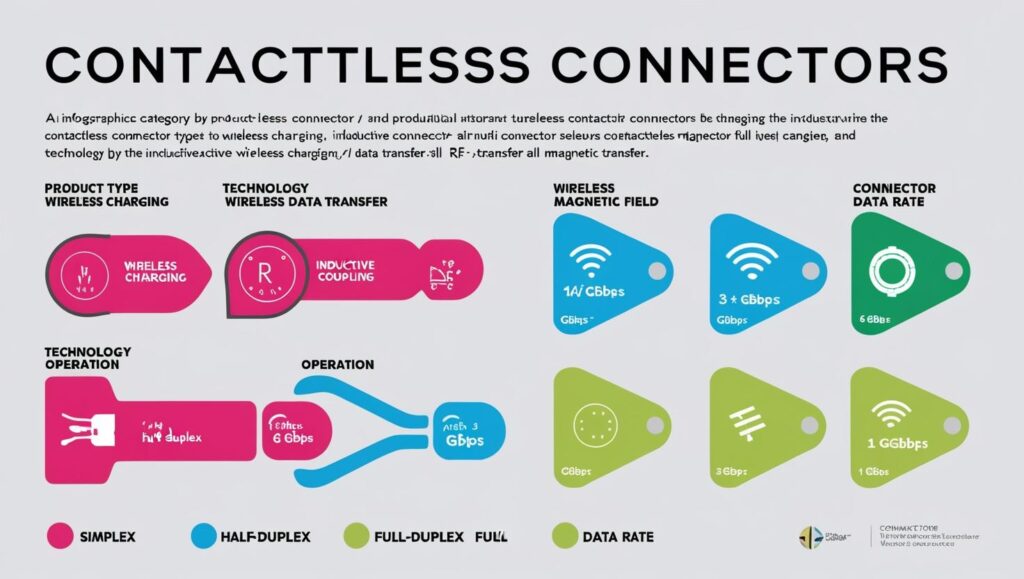The global demand for efficient, reliable, and seamless communication systems has been exponentially growing, and as a result, numerous industries have started to embrace innovative technologies to facilitate better communication, energy transfer, and data exchange. One such advancement is the contactless coupler technology—a breakthrough in wireless power transfer (WPT) and data communication systems that enables seamless energy and data transfer without the need for physical connectors.
While traditional connectors rely on wired systems to complete circuits or transfer data, contactless couplers operate through electromagnetic fields—specifically via inductive or capacitive coupling—which removes the need for physical contact. This groundbreaking technology is at the forefront of multiple industries, from telecommunications to electric vehicles (EVs), consumer electronics, and industrial automation.
Explores the burgeoning contactless coupler market, its key drivers, trends, and challenges, and the pivotal opportunities emerging across a variety of sectors, ranging from smart homes and healthcare to industrial automation and automotive. Through these lenses, we will explore how contactless couplers are advancing wireless connectivity and how industries stand to benefit from these innovations.
Understanding Contactless Couplers and Their Mechanisms
Contactless couplers, also known as wireless couplers, are devices that facilitate power and data transmission without the need for direct physical contact between components. Their primary function is to use electromagnetic fields to wirelessly transfer power or information between two systems. These systems typically rely on inductive coupling, where electromagnetic fields are used to induce currents in another circuit, or capacitive coupling, where the transfer is facilitated through electric fields.

How Contactless Couplers Work
Inductive Coupling: In an inductive system, an electromagnetic field is created by a coil of wire carrying an alternating current. A second coil is placed within this electromagnetic field, and the current induced in the second coil enables power or data transfer. This is commonly seen in wireless charging systems, where energy is transferred between the charging pad and the device being charged.
Capacitive Coupling: In capacitive coupling, an electric field is created between two electrodes, which allows the transfer of energy or data through the air or a non-conductive medium. This mechanism is frequently used in contactless payment systems and some wireless data transfer technologies.
Types of Contactless Couplers
Power Transfer Systems: These couplers are mainly used for transferring energy wirelessly, for instance in electric vehicle (EV) charging stations or wireless chargers for mobile phones and other consumer devices.
Data Transfer Systems: These systems are designed for transferring data without physical cables, such as in wireless communication systems, IoT devices, and industrial sensors.
Key Drivers of Market Growth
Several macro trends are driving the contactless coupler market, with industries seeking advanced solutions to improve efficiency, reduce maintenance costs, and enhance user experiences. The key drivers of growth can be broken down into several categories:
1. Rise in Demand for Wireless Solutions
The shift towards wireless communication and power solutions is being driven by the need for more flexible, scalable, and efficient technologies. Wireless solutions eliminate the need for cumbersome cables and connectors, enabling a cleaner and more aesthetically pleasing environment for consumers and industries. With the increasing adoption of the Internet of Things (IoT), connected devices, and smart technologies, the need for wireless communication and power transfer is more pronounced than ever. Contactless couplers are at the heart of this revolution, providing a reliable way to transfer energy and data across systems.
2. Growth in Electric Vehicle (EV) Charging Infrastructure
The automotive sector, particularly electric vehicles (EVs), is one of the primary sectors benefiting from the rise of contactless coupler technologies. The global shift towards electric mobility has driven innovation in charging solutions. Traditional wired charging infrastructure, while effective, presents several challenges, such as wear and tear, maintenance costs, and the inconvenience of plugging and unplugging. Wireless EV charging, powered by contactless coupler technology, offers a solution to these challenges, providing greater convenience, safety, and efficiency. As the adoption of electric vehicles increases, so too does the demand for advanced charging infrastructure, positioning contactless couplers as an essential component of future EV networks.
3. Advancements in Industrial Automation
The ongoing digital transformation in industries such as manufacturing, logistics, and warehousing is another key driver of the contactless coupler market. Industrial automation is becoming increasingly reliant on connected systems, sensors, and actuators that can communicate wirelessly. Traditional wiring systems are often cumbersome and costly to maintain, especially in harsh industrial environments. By replacing physical connectors with wireless contactless couplers, manufacturers can reduce maintenance costs, enhance system reliability, and improve operational efficiency. Additionally, wireless systems are more adaptable, enabling industries to scale operations without extensive physical wiring.
Download PDF Brochure @ https://www.marketsandmarkets.com/pdfdownloadNew.asp?id=63364524
4. Consumer Electronics and Wearables Market Growth
Consumer electronics and wearables have seen rapid advancements in wireless technologies, particularly when it comes to wireless charging and data transfer. Contactless couplers are increasingly used in consumer products like smartphones, smartwatches, tablets, and laptops, where wireless charging capabilities are becoming a standard feature. As the demand for convenience and user-friendly interfaces increases, manufacturers are turning to contactless couplers to enable seamless power and data transmission without the need for physical connectors.
5. Increased Focus on Safety and Sustainability
Contactless couplers can improve safety by eliminating the need for physical connectors, reducing the risks of electrical fires, sparks, and short circuits, particularly in hazardous or high-voltage environments. Furthermore, these systems promote sustainability by reducing the need for cables, connectors, and other physical components that contribute to electronic waste. As industries and consumers alike continue to seek sustainable and eco-friendly alternatives, the demand for wireless solutions like contactless couplers will continue to grow.
Chapter 3: Key Challenges in the Contactless Coupler Market
While the contactless coupler market holds immense potential, it also faces several challenges that need to be addressed for widespread adoption.
1. Power Loss and Efficiency Challenges
Although contactless couplers are highly efficient, there are still challenges related to power loss during wireless energy transmission. The efficiency of power transfer can be impacted by factors like distance, alignment, and material interference. In applications such as wireless charging for electric vehicles, even small losses in efficiency can have significant financial and operational implications. Continued research and development in technologies like resonant inductive coupling and magnetic resonance are expected to enhance the power transfer efficiency of contactless couplers.
2. High Initial Investment
While contactless coupler systems are gaining popularity, their initial installation and integration costs can be prohibitive, particularly for industries like manufacturing and healthcare. This challenge is compounded by the need to retrofit existing infrastructure to accommodate wireless systems. Although the long-term benefits, such as reduced maintenance and operational costs, outweigh the initial investment, the upfront capital required can be a barrier to adoption.
3. Lack of Standardization
The absence of globally accepted standards for contactless coupler technologies presents a challenge in terms of interoperability. The market is still evolving, and many companies are developing proprietary systems that may not work with others. Establishing industry-wide standards is essential to ensure that different devices and systems can work seamlessly together, improving the overall adoption of wireless power and data transfer systems.
4. Technological Barriers
Technological limitations, such as range, power limitations, and data transfer speeds, still exist in some contactless coupler systems. In some cases, the power delivered wirelessly may be too low to power larger devices, or the distance over which power can be transmitted may be limited. These limitations must be overcome in order for the technology to reach its full potential across industries.

Future Growth Opportunities and Applications
As industries increasingly adopt wireless technologies, the future of the contactless coupler market looks promising. Several areas of growth and application include:
1. Smart Homes and Buildings
In the rapidly growing smart home sector, contactless couplers can enhance the functionality and convenience of connected devices. Wireless power systems can eliminate the need for charging cables for devices such as smart thermostats, lighting systems, and security cameras. This will not only make smart homes more user-friendly but will also reduce clutter and enhance aesthetic appeal.
2. Healthcare
In the healthcare industry, contactless couplers are finding applications in medical devices that require continuous operation without physical connectors. Wearable health trackers and implants often need to be recharged or continuously powered, and contactless couplers provide a safe and efficient way to power these devices. Additionally, wireless data transfer via contactless couplers can ensure that patient data is securely transmitted without physical connections, reducing the risk of contamination or injury.
3. Retail and Logistics
In retail and logistics, contactless couplers can streamline operations by enabling wireless communication between inventory tracking systems, sensors, and devices. This can enhance real-time monitoring, improve inventory management, and optimize supply chains.
4. Electric Vehicles (EVs) and Autonomous Vehicles
As the electric vehicle market grows, the demand for wireless charging and contactless power systems will continue to rise. This can simplify charging infrastructure and improve the overall user experience for EV owners. Additionally, autonomous vehicles can leverage contactless couplers for data transfer between various sensors and systems without relying on physical connections.
The contactless coupler industry is experiencing significant growth as industries around the world seek more efficient, reliable, and scalable wireless technologies. With applications spanning electric vehicles, consumer electronics, industrial automation, and smart homes, the potential for growth is vast. However, challenges such as power loss, high initial investments, and the lack of standardization must be addressed to fully realize this potential.
As technology continues to advance and the demand for wireless connectivity grows, contactless couplers will play an increasingly pivotal role in revolutionizing industries, making them smarter, more efficient, and more sustainable. Embracing this technology will be crucial for businesses looking to stay competitive in the digital age.
The Contactless connector industry includes significant Tier I and II players like:
- STMicroelectronics (Switzerland),
- TE Connectivity (Switzerland),
- Molex (US),
- Rosenberger Hochfrequenztechnik GmbH & Co. KG (Germany),
- Radiall (France), and others. These players have a strong market presence for Contactless connectors across various North America, Europe, Asia Pacific, and RoW countries.
About MarketsandMarkets™
MarketsandMarkets™ is a blue ocean alternative in growth consulting and program management, leveraging a man-machine offering to drive supernormal growth for progressive organizations in the B2B space. We have the widest lens on emerging technologies, making us proficient in co-creating supernormal growth for clients.
The B2B economy is witnessing the emergence of $25 trillion of new revenue streams that are substituting existing revenue streams in this decade alone. We work with clients on growth programs, helping them monetize this $25 trillion opportunity through our service lines – TAM Expansion, Go-to-Market (GTM) Strategy to Execution, Market Share Gain, Account Enablement, and Thought Leadership Marketing.
Built on the ’GIVE Growth’ principle, we work with several Forbes Global 2000 B2B companies – helping them stay relevant in a disruptive ecosystem. Our insights and strategies are molded by our industry experts, cutting-edge AI-powered Market Intelligence Cloud, and years of research. The KnowledgeStore™ (our Market Intelligence Cloud) integrates our research, facilitates an analysis of interconnections through a set of applications, helping clients look at the entire ecosystem and understand the revenue shifts happening in their industry.
To find out more, visit www.MarketsandMarkets™.com or follow us on Twitter, LinkedIn and Facebook.
Contact:
Mr. Rohan Salgarkar
MarketsandMarkets™ INC.
1615 South Congress Ave.
Suite 103
Delray Beach, FL 33445
USA : 1-888-600-6441